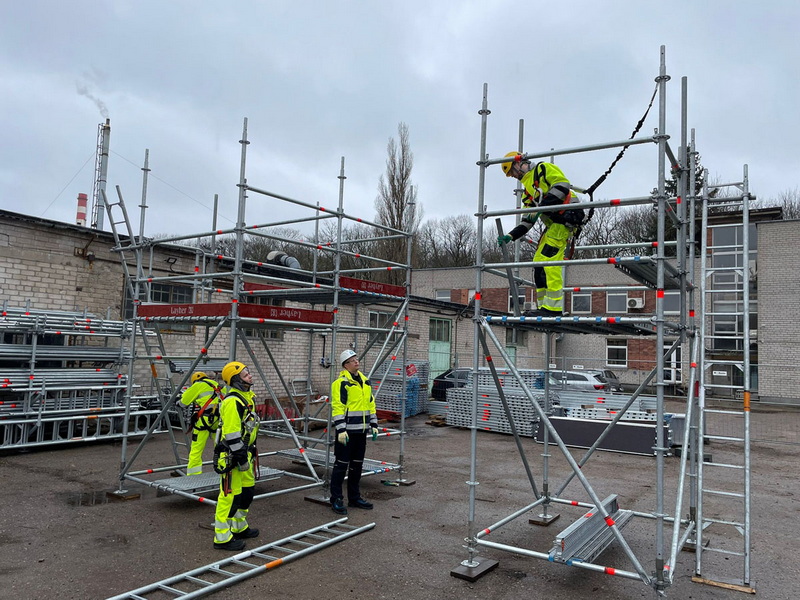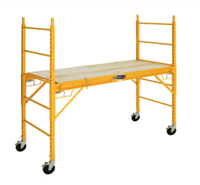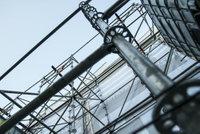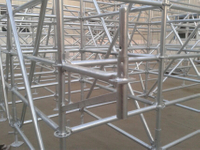Content Menu
● Introduction to A Frame Scaffolding
● Importance of Safety Training
● Key Safety Rules for A Frame Scaffolding
>> 1. Proper Setup and Inspection
>> 2. Fall Protection
>> 3. Load Capacity
>> 4. Environmental Considerations
>> 5. Training and Supervision
● Regulatory Compliance
● OSHA Guidelines
● Comprehensive Training Programs
>> Practical Training and Emergency Response
>> Emergency Procedures and Rescue Training
● Risk Assessment and Hazard Awareness
● Steps for Conducting a Risk Assessment
● Manual Handling and Ergonomics
● Strategies for Safe Manual Handling
● Best Practices for Frame Scaffolding
● Conclusion
● FAQ
>>> 1. What are the key components of A Frame scaffolding safety training?
>> 2. How often should A Frame scaffolding be inspected?
>> 3. What are the consequences of not following safety rules in A Frame scaffolding?
>> 4. Can A Frame scaffolding be used in adverse weather conditions?
>> 5. What role does training play in A Frame scaffolding safety?
● Citations:
A Frame scaffolding is a versatile and widely used tool in construction and maintenance projects. It provides a stable platform for workers to perform tasks at heights safely. However, like any scaffolding system, it requires careful setup and adherence to safety rules to prevent accidents. In this article, we will delve into the key safety rules covered in A Frame scaffolding training, emphasizing the importance of proper setup, safety protocols, and regulatory compliance.

Introduction to A Frame Scaffolding
A Frame scaffolding, also known as ladder scaffolding, is characterized by its A-shaped structure, which provides stability and support for workers. It is commonly used for tasks that require access to high areas, such as painting, repairs, and maintenance. Despite its simplicity, A Frame scaffolding poses risks if not used correctly, making comprehensive training essential.
Importance of Safety Training
Safety training is crucial for anyone working with A Frame scaffolding. It covers not only the technical aspects of setting up the scaffolding but also how to identify and mitigate potential hazards. Training programs typically include modules on:
- Scaffold Setup and Inspection: Ensuring that the scaffolding is properly assembled and inspected before use.
- Fall Protection: Understanding when and how to use personal fall arrest systems (PFAS) or guardrails.
- Load Capacity: Recognizing the maximum weight limits of the scaffolding and ensuring it is not overloaded.
- Environmental Factors: Being aware of weather conditions and other environmental factors that could affect scaffolding stability.
Key Safety Rules for A Frame Scaffolding
1. Proper Setup and Inspection
Proper setup is critical to ensure the scaffolding is stable and secure. This includes:
- Leveling the Scaffolding: Use adjustable legs to ensure the scaffolding is level on uneven surfaces.
- Securing Components: Ensure all parts are securely locked in place.
- Regular Inspections: Conduct daily inspections to check for damage or wear.
2. Fall Protection
Fall protection is essential when working at heights. This includes:
- Guardrails: Installing guardrails around the platform to prevent falls.
- Personal Fall Arrest Systems (PFAS): Using PFAS when guardrails are not feasible.
3. Load Capacity
Overloading can lead to structural failure. Always:
- Check Manufacturer's Guidelines: Ensure the scaffolding is not overloaded beyond its capacity.
- Monitor Weight: Keep track of the weight on the scaffolding at all times.
4. Environmental Considerations
Environmental factors can significantly impact scaffolding safety:
- Weather Conditions: Avoid using scaffolding during adverse weather conditions like strong winds or rain.
- Surface Conditions: Ensure the area around the scaffolding is free from slippery substances.
5. Training and Supervision
Proper training and supervision are crucial for safe scaffolding use:
- Training Programs: Ensure all workers are trained in the safe use of A Frame scaffolding.
- Supervision: Supervise inexperienced workers closely during setup and use.
Regulatory Compliance
Regulatory compliance is essential to ensure that scaffolding operations meet safety standards. This includes adhering to guidelines set by organizations like OSHA in the U.S. or similar bodies in other countries.
OSHA Guidelines
OSHA provides detailed guidelines for scaffolding safety, including:
- Pre-Operation Inspections: Conducting thorough inspections before use.
- Guardrail Requirements: Ensuring guardrails are installed correctly.
- Fall Protection: Mandating the use of PFAS when necessary.

Comprehensive Training Programs
A comprehensive training program for A Frame scaffolding should include both theoretical and practical components. Theoretical training covers safety protocols, regulatory compliance, and hazard identification. Practical training involves hands-on experience with assembling, inspecting, and using the scaffolding safely.
Practical Training and Emergency Response
Effective training programs must include practical, hands-on components where workers can apply what they have learned in controlled environments. It allows them to practice scaffold assembly and disassembly, conduct inspections, and perform risk assessments, all under the guidance of experienced instructors.
Emergency Procedures and Rescue Training
Workers should receive training in emergency response procedures apart from scaffold-specific training. This includes first aid basics, evacuation plans, and rescue techniques for individuals who may have fallen from a height. Proper training in emergency procedures ensures that workers are prepared for any situation.
Risk Assessment and Hazard Awareness
A key component of any scaffolding training program is learning to recognize hazards and assess risks. Workers must be trained to evaluate their work surroundings to ensure safe scaffold use. This includes identifying potential electrical hazards, examining ground stability, and accounting for overhead obstructions[1].
Steps for Conducting a Risk Assessment
1. Identify Potential Hazards: List all possible hazards such as uneven ground, overhead wires, and nearby obstructions.
2. Assess Risks: Evaluate the likelihood and impact of each hazard.
3. Implement Control Measures: Use safety equipment and procedures to mitigate identified risks.
Manual Handling and Ergonomics
Manual handling plays a significant role in scaffolding safety, particularly during assembly and disassembly phases. It involves identifying manual handling tasks, assessing potential hazards, evaluating risks, and implementing control measures to prevent injuries[5].
Strategies for Safe Manual Handling
- Use Mechanical Aids: Employ hoists or pulleys to reduce manual lifting.
- Break Down Loads: Divide heavy components into smaller, manageable parts.
- Train Workers: Ensure workers receive proper training on manual handling techniques.
Best Practices for Frame Scaffolding
To ensure safety and efficiency, adhere to the following best practices when using frame scaffolding:
1. Conduct Thorough Inspections: Inspect all components for damage before assembly and during the project[2].
2. Follow Manufacturer Guidelines: Adhere to manufacturer instructions for assembly, use, and disassembly[2].
3. Provide Adequate Training: Ensure all personnel are trained in safety protocols and emergency procedures[2].
4. Implement Fall Protection Measures: Use guardrails, toeboards, or PFAS to protect workers from falls[2].
Conclusion
A Frame scaffolding training is designed to equip workers with the knowledge and skills necessary to safely use this equipment. By following the safety rules outlined in this article, workers can minimize risks and ensure a safe working environment. It is crucial to remember that safety is a collective responsibility, requiring the active participation of all stakeholders involved in scaffolding operations.

FAQ
1. What are the key components of A Frame scaffolding safety training?
A Frame scaffolding safety training covers essential topics such as proper setup, fall protection, load capacity, environmental considerations, and regulatory compliance. It emphasizes the importance of regular inspections and adherence to manufacturer guidelines.
2. How often should A Frame scaffolding be inspected?
A Frame scaffolding should be inspected daily before use to ensure all components are in good condition and properly secured. Regular inspections help identify potential hazards early.
3. What are the consequences of not following safety rules in A Frame scaffolding?
Not following safety rules can lead to accidents, injuries, and even fatalities. It can also result in legal and financial repercussions for non-compliance with safety regulations.
4. Can A Frame scaffolding be used in adverse weather conditions?
No, A Frame scaffolding should not be used during adverse weather conditions such as strong winds, rain, or snow, as these can compromise the stability of the scaffolding.
5. What role does training play in A Frame scaffolding safety?
Training plays a critical role in A Frame scaffolding safety by educating workers on how to set up, inspect, and use the scaffolding safely. It helps prevent risky behaviors and ensures compliance with safety standards.
Citations:
[1] https://www.turboscaffolding.com.au/blog/mobile-scaffold-training-guide/
[2] https://www.actionscaffold.com/post/a-comprehensive-guide-to-frame-scaffolding-everything-you-need-to-know
[3] https://www.oshaoutreachcourses.com/blog/scaffolding-safety-guide/
[4] https://www.ccohs.ca/oshanswers/safety_haz/platforms/setup.html
[5] https://fatfinger.io/scaffolding-safety-when-working-at-height/
[6] http://www.osha.gov/etools/scaffolding/supported/frame
[7] https://www.osha.gov/sites/default/files/publications/osha3150.pdf
[8] https://techehs.com/blog/scaffolding-safety-a-comprehensive-guide-for-site-managers






















